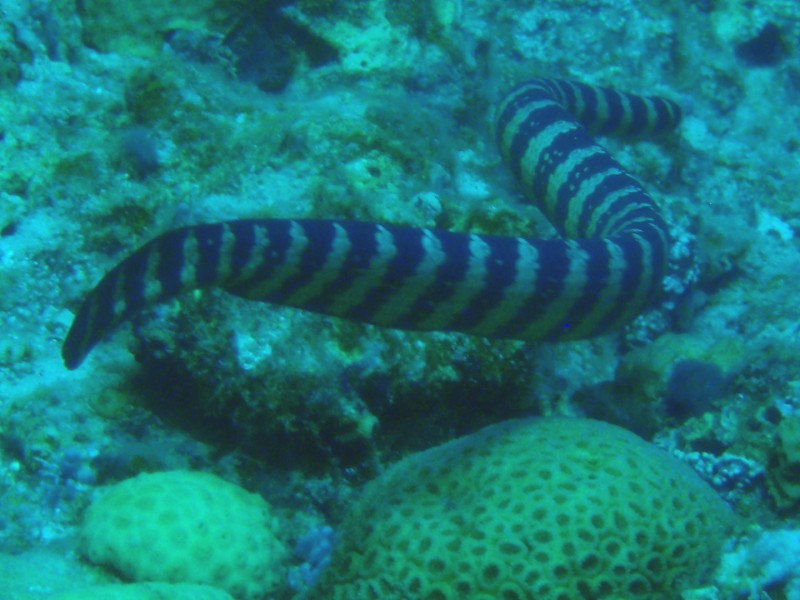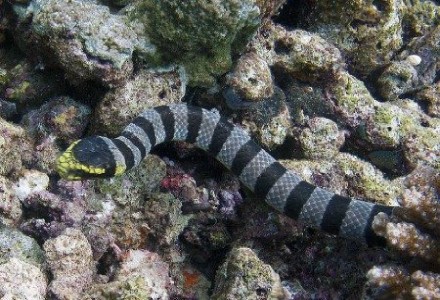
Black Banded Sea Krait Facts
- Most notably, the term Black Banded Sea Krait seves as the common name for the Laticauda semifasciata. The animal also remains known as the Chinese sea snake. By either name, the remarkable reptile constitutes a rather dangerous species of sea snake in all parts of its range.
- Fortunately for human beings, however, the powerful animal typically remains comparatively timid in nature. Yet, like all living things, it only remains so as long as it does not feel threatened. This incredibly dangerous species will attack if it believes itself to be under serious threat.
- Furthermore, this rather surprising snake also distinguishes itself from related creatures in a truly remarkable manner. That’s because it has a habit unlike any other known species of sea snake. This unique creature appears to be almost as much at home on the land as it does in the ocean.
- That truly fascinating, and somewhat startling, fact holds true due to an astounding behavioral trait. Within certain portions of its geographic range, you can commonly see a number of individuals of this species emerge from the ocean and hang from low tree branches.
Related Articles
Green Sea Turtle Olive Sea Snake Marine Iguana
Public Domain Image
Black Banded Sea Krait Physical Description
Most notably, somewhat large black bands cover much of the body of the Black Banded Sea Krait. However, the rest of the body often presents a moderately wide variety of colors. In addition, the end of the tail of this snake develops as rather flattened and visibly paddle-shaped in nature.
Further, it displays the trait of sexual dimorphism. In its case, the female of this particular variety attains a significantly larger size than the male. That’s because the females average a body length of roughly 50 in (128 cm). Meanwhile, the males only average a body length of about 30 in (75 cm).
In addition, it possesses yet another noteworthy attribute. That holds true due to the fact that the venom of this rather deadly reptile qualifies as a powerful neurotoxin. In fact, its toxin averages being 10 times as potent as that of a cobra. But, this venom does possess useful medical applications.
Finally, this snake also possesses fully functional lungs. These evolved to a large enough size to allow it to remain submerged for several hours at a time. But, this remarkable adaptation also lets it venture onto land when it wishes to.
- Kingdom: Animalia
- Phylum: Chordata
- Class: Reptilia
- Order: Squamata
- Family: Elapidae
- Genus: Laticauda
- Species: L. semifasciata
Black Banded Sea Krait Distribution, Habitat, and Ecology
The Black Banded Sea Krait seems to be endemic to a rather extensive territorial range. That area includes Japan, Sri Lanka, the Philippines, the Pacific Islands, and also New Guinea. This truly impressive sea-going reptile also has a strong presence throughout Southeast Asia.
Furthermore, within that area, it has a highly specific preference for its desired habitat. Due to this, the animal most commonly inhabits coastal regions, allowing it access to land. As a result, this creature still remains the only known amphibious variety of sea snake.
When individuals come ashore, these also have specific preferences. There, it most commonly inhabits areas of mangrove forest, coral reefs, or secluded beaches. When on land individuals appear to be primarily nocturnal in nature.
The snake preys primarily on a variety of eels, but will also feed on small fish. Meanwhile, its own predators remain few in number. These primarily include sharks, seabirds, as well as certain larger bony fish. Unique among its kind, again, this fascinating species lays its eggs on land, usually on small beaches.
Species Sharing Its Range
Thresher Shark Bobbit Worm Philippine Crocodile
Check out our other articles on 7 Spectacular Geological Marvels of Europe, Inaccessible Island Rail, Mount Erebus, Eastern Tent Caterpillar, Northern Elephant Seal

